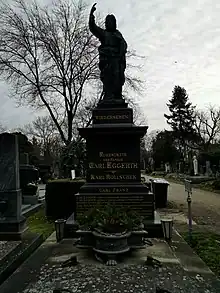Karl Eggerth
Karl Eggerth junior (1861-1888) was an Austrian botanist and medical student who specialised in collecting lichen specimens.
Karl Eggerth junior | |
|---|---|
| Born | 1 November 1861[1] Vienna[1] |
| Died | 30 March 1888 (aged 26)[1] Vienna [1] |
| Resting place | Vienna Central Cemetery |
| Scientific career | |
| Fields | Botany, Lichenology. |

The grandson of the owner of the Viennese Karolinenbad and Esterházybad bathhouses of Mariahilf district, Josef Eggerth (1804-1878), and the son of Karl Eggerth the elder (1834-1888), the younger Karl was born on 1 November, 1861, into a prominent, wealthy family. His father had taken over the running of his father's bathhouses by the 1850s, and it is for Karl Eggerth senior that the Eggerthgasse was renamed in his honour.[2]
Along with the Eggerth's entrepreneurial spirit, the family was also interested in natural history. Josef had donated a specimen of Deinotherium giganteum to the Imperial-Royal Geological Institution of Vienna, which had been unearthed during excavations for the Esterházybad in 1857.[3] Karl senior was a mineral and meteorite collector, who had donated glass models, zoological specimens, and fragments of a meteorite to the Kremsmünster monastic observatory.[1][3][4]
By 1880, Karl junior had graduated from the Kremsmünster Stiftsgymnasium (Kremsmünster monastic secondary school) and started to study medicine in Vienna.[5] But Eggerth's true passion was lichenology, and from the time he graduated from the Gymnasium until his death, he undertook many collecting trips, and purchased and exchanged specimens to build a personal collection of approximately 35,000 specimens.[1][3] He was friends with Richard Wettstein, and together they founded the student-led Natural Science Association at the University of Vienna in 1882.[3] Eggerth was also close friends with Hugó Lojka, and arranged his scientific estate after his death.[3][6]
From 1882 Eggerth was a member of the Zoologisch-Botanischen Gesellschaft in Wien (Zoological-Botanical Society of Vienna) and from 1886 he was a member of der Deutschen botanischen Gesellschaft (the German Botanical Society).[3] Both Wettstein and Eggerth were recruited by Kerner von Marilaun to collect specimens for his Flora exsiccata Austro-Hungarica exsiccata,[5][3] but he also collected for Arnold's Lichenes exsiccati, and Lojka's Lichenotheca universalis, which is how specimens collected by Karl Eggerth have entered herbarium collections around the world.[5]
After heart disease causing a "brief, painful illness" Karl junior died on March 30, 1888, and was interred at the Vienna Central Cemetery in the family grave. He never completed his medical studies.[1][5]
Collections
Eggerth cultivated relationships with many lichenologists of his time, which included his acquisition of a large part of August von Krempelhuber's Europäischen Flechten (European Lichens).[3][7]
After Eggerth's death his father, donated his son's personal herbarium to the then-Botanical Museum of the University of Vienna (now known as the Herbarium der Universität Wien (WU)). Specimens collected by Eggerth today can be found in herbaria including Herbarium der Universität Wien,[8] the National Herbarium of Victoria, Royal Botanic Gardens Victoria,[9] and the Herbarium of Te Papa Tongarewa[10]
His microscope and portrait are still cared for by the museum at Kremsmünster.[11][5]
Significant publications
- Karl Eggerth (1887) "Nachtrag zur Lichenenflora von Corfu." Flora oder Allgemeine Botanische Zeitung. 70: 482.PDF
References
- Svojtka, M. (15 December 2020). "Eggerth, Karl d. J. (1861–1888), Botaniker". Österreichisches Biographisches Lexikon ab 1815. Austrian Centre for Digital Humanities and Cultural Heritage. Retrieved 9 February 2023.
- "Eggerthgasse". Wien Geschichte Wiki. Stadt Wien. 7 May 2021. Retrieved 9 February 2023.
- Svojtka, Matthias (2009). "Sammler als Wegbereiter naturwissenschaftlicher Erkenntnis – Fallstudien Leopold Johann Nepomuk von Sacher-Masoch (1797-1874) und Karl Eggerth (1861-1888)". Berichte der Geologischen Bundesanstalt. 45: 40–43. Retrieved 9 February 2023.
- Kraml, P. Amand (16 September 2021). "Objekt des Monats aus dem Museum der Sternwarte Kremsmünster: April 2012". Sternwarte Kremsmünster, Specula Cremifanensis. Retrieved 9 February 2023.
- Kraml, P. Amand (16 September 2021). "Objekt des Monats aus dem Museum der Sternwarte Kremsmünster November 2007". Sternwarte Kremsmünster, Specula Cremifanensis. Retrieved 9 February 2023.
- Galloway, David (2014). "Hugo Lojka (1845-1887) and the New Zealand lichens in Lichenotheca Universalis III (1886)" (PDF). British Lichen Society Bulletin. 114: 5–22. Retrieved 9 February 2023.
- Hertel, Hannes; Gärtner, Georg; Lökös, László; Farkas, Edith (2017). "Forscher an Österreichs Flechtenflora". Stapfia. 104: 38. Retrieved 9 February 2023.
- "JACQ Database Search". Retrieved 19 December 2022.
- "Australasian Virtual Herbarium: National Herbarium of Victoria". Retrieved 19 December 2022.
- "Australasian Virtual Herbarium: Herbarium of the Museum of New Zealand Te Papa Tongarewa". Retrieved 19 December 2022.
- Kraml, P. Amand (9 March 2011). "Reichert-Mikroskop von Karl Eggerth jun". Objekt des Monats aus dem Museum der Sternwarte Kremsmünster. Sternwarte Kremsmünster Specula Cremifanensis. Retrieved 19 December 2022.
- International Plant Names Index. Eggerth.